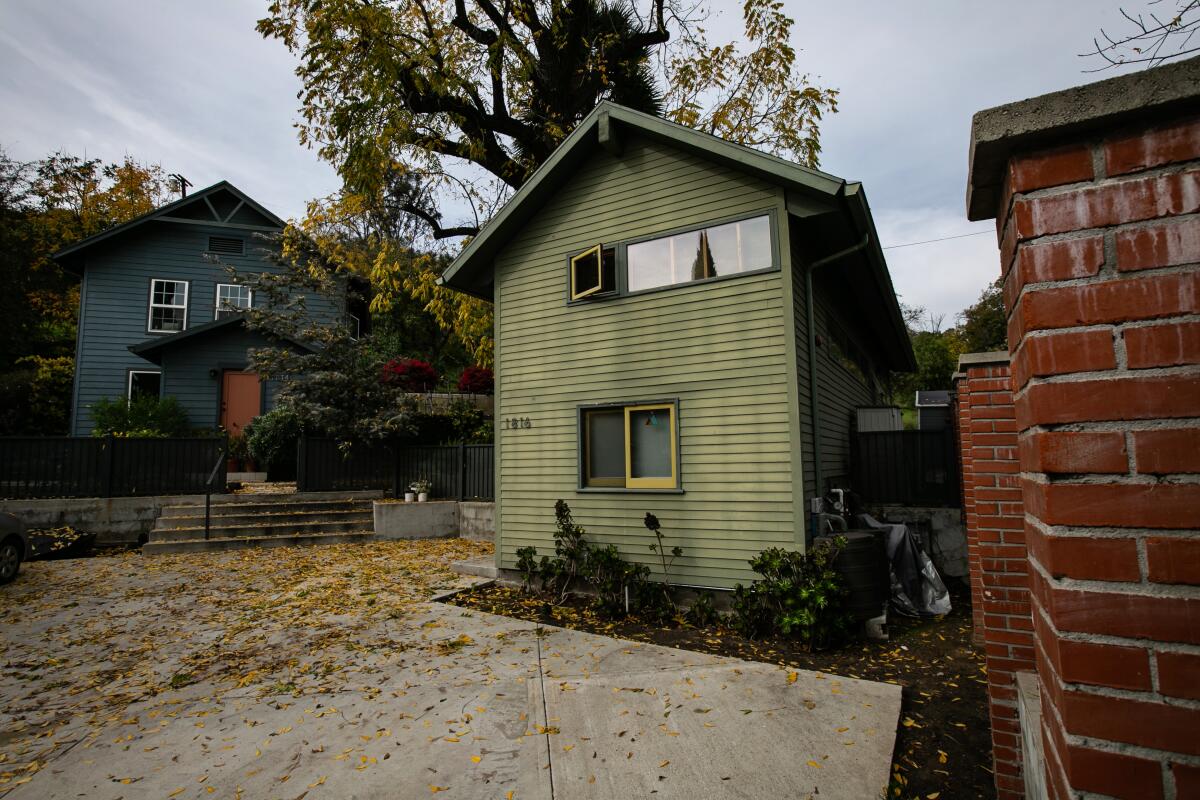Costa Mesa council green-lights ‘granny flat’ expansion as city looks to meet housing mandate

- Share via
Before the most recent state effort to ease restrictions on the building of accessory dwelling units on residential lots as a means of addressing California’s housing shortage, Costa Mesa took a literal interpretation on “granny flats.”
Historically, such structures could only be occupied by individuals 62 years of age and older. Other accessory structures built on a property, such as detached bonus rooms, were allowed by right or with a permit so long as they contained a bathroom.
But all that is about to change. Costa Mesa City Council members Tuesday considered a new citywide ordinance that would condone a much wider range of dwelling units, partly to bring the city in compliance with a host of new state mandates but also to begin addressing the city’s own obligation to increase its housing stock and improve affordability.
City officials passed a temporary urgency ordinance in Dec. 2019, after a series of state housing laws were passed requiring cities relax or eliminate development standards for the units, to buy time while planners drafted new regulations.
Brought to Costa Mesa’s Planning Commission in July and further refined in the months that followed, the new ordinance came to council Tuesday for an initial airing. It attempts to establish a standard for how park impact fees might be levied and includes specifications pertaining to size, height and setbacks.
“It was important for us to ensure we would have standards that would maintain the accessory nature of ADUs as much as possible,” said Jennifer Le, the city’s economic and development services director. “Otherwise, you would appear to have a duplex or a triplex.”
The ordinance distinguishes between ADUs — which may be attached to a primary dwelling (and built up to 1,000 square feet) or detached (up to 1,200 square feet) — and junior accessory dwelling units, when a portion of the primary residence is converted into a semi-independent dwelling. Such units are capped at 500 square feet.
State laws undo lot-size requirements and permit owners of single-family residences to build at least one dwelling unit and one junior accessory dwelling unit on a property, while multifamily properties may build up to two detached units no larger than 800 square feet in size.
Frontyard setbacks must be maintained at 20 feet. Rear and interior side setbacks must be at least 4 feet from a property line, while a 10-foot side setback is required for an exterior lot line.
Single-story units must be under 16 feet high, while two-story units can be built up to 27 feet and must maintain at least 20 feet of space to the front and rear lines of a property, with a further 5-foot recess of the second story in front to minimize mass.
Council members discussed recommendations put forth by the planning commission, which advised all efforts be made to encourage ADU building among property owners.
A former commissioner who joined the council following the Nov. 3 election, Jeff Harlan said it was important for the city to employ all mechanisms to increase housing.
“Given the current state of affairs with the housing situation, I think ADUs are going to play some role, but I don’t know how large in Costa Mesa,” Harlan said.
Costa Mesa currently is required by the state to plan and zone for an additional 11,733 residential units by 2029, and accessory dwelling units may account for a portion of that obligation. Since the city first created ADU guidelines in 2017, however, only 40 applications have come in with just 14 projects built so far.
While some cities previously attempted to establish parking requirements for newly built units, state mandates waive restrictions for areas within half a mile of a transit route, which applies to 90% of Costa Mesa properties. Council members went one step further Tuesday, opting to forego parking requirements for all accessory dwelling units.
Councilman Don Harper did not favor loosening restrictions for accessory units, saying they had the potential to change the character of the neighborhoods they’re built in. He said the state’s imposition on cities in the matter was unfair.
“The [long-term] impact can be significant, because what you’re allowing for is a neighborhood to double its population,” he said. “And that doubles the strain on traffic, parking, sewer, water, electricity and parks — everything around that neighborhood.”
With Katrina Foley abstaining (as she is currently building an ADU on her own property), council members supported the new ordinance in a 5-1 vote, with Harper casting the lone dissenting vote. The matter will return for a second reading at a future meeting.
All the latest on Orange County from Orange County.
Get our free TimesOC newsletter.
You may occasionally receive promotional content from the Daily Pilot.




